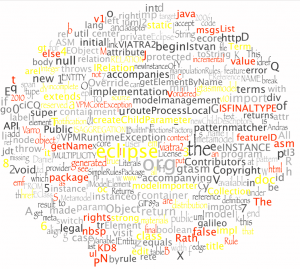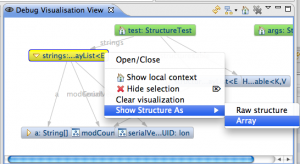Today I read the announcement of SourceCloud, a new Zest/Cloudio-based visualization for source code. As I like cool visualizations, I tried it out on the open projects I am participating in.At first I created the cloud for the source code of the Debug Visualisation project. Globally it consists of about half Eclipse debugger/UI and Java keywords – as this is quite a small project (about 4 kLOC), this is somewhat expected with 200 words.

However, it is interesting, that the strings ‘end_of_line‘ and ‘sp_cleanup‘ found their way in. Luckily, only a few one-character names and numbers are present, meaning, we managed to created longer variable names…
The cloud of the VIATRA2 model transformation framework is more interesting: it is a much larger codebase, developed for several year by around a dozen people. Because of the size I generated the cloud using 300 words, but almost no Java keywords found their way into the graph.

However, the mandatory comment parts did, e.g. nbsp or the names of some creators. A lot of EMF-specific keywords are also present. They are present because we have quite a large EMF metamodel that provides several hundred generated Java files.
At last, but not least I also checked the cloud of the EMF-IncQuery project. This is smaller, then the VIATRA2 project, but larger then the Debug Visualisation. Additionally, it has a shorter history, but with several key committers.

My personal favorite is this diagram, as it shows a lot of nice things: e.g. four digit numbers in large quantities (magic numbers FTW) or the absolute champion string: ‘HUKfyM7ahfg‘. All of them are present in the Ecore Diagram of the defined metamodel (the meaningless string 152 times as a postfix of an identifier 🙂 ). At least, I learned something about the internal model representation of GMF.
And how do your projects look like?



